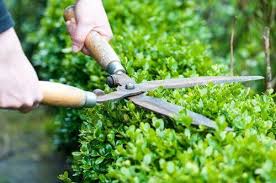Hedges are formed by planting shrubs or trees in a row, creating a solid, linear mass that has been used by gardeners for centuries as screens, fences, and decorative edges.
Achieving a well-shaped hedge requires careful training from the start. When establishing a deciduous hedge, select young plants that are 1 to 2 feet tall and preferably multiple-stemmed. Upon planting, cut the plants back to 6 or 8 inches to encourage low branching. In late summer of the first year or before bud break the next season, prune half of the new growth. Repeat this process in the following year to promote further branching.
Shaping the hedge typically begins in the third year. While hedges are often shaped with flat tops and vertical sides, a more natural form—rounded or slightly pointed tops with slanting sides leading to a wider base—is generally healthier for the plants. To maintain low branching, trim the top narrower than the bottom, allowing sunlight to reach all leaves. Rounded or peaked tops also help shed snow, preventing branch breakage.
Consider the natural shape of the untrimmed plants before shaping. For example, naturally conical arborvitae can be shaped into a Gothic arch, while spreading plants like common buckthorn suit a Roman arch. Trim to the desired shape before the hedge reaches its final height; allowing it to grow untrimmed first can hinder maximum branching at the base. Once the hedge has reached the desired dimensions, trim closely to keep it within bounds.
Evergreen hedges do not need to start as small as deciduous ones and should not be cut back when planted. Instead, lightly trim them after a year or two and begin shaping as they merge into a continuous hedge. Avoid trimming too closely, as many needle-bearing evergreens struggle to generate new growth from old wood.
Common questions about hedge maintenance include how often to trim and when to do so. Generally, trim before growth exceeds 1 foot. Slow-growing plants, like boxwood, may require more frequent trimming. Untrimmed growth can lead to leaf loss beneath and an unkempt appearance, especially in weak-stemmed shrubs. In mountainous areas, yews and other evergreens may need shearing only once a year, while milder regions may require two or three shearings. Deciduous plants should be trimmed earlier than July, after the spring growth flush, and may need additional trimming depending on the type of shrub and desired neatness.
For large, overgrown hedges, especially deciduous ones, prune them back to one foot below the desired height in early spring before leaves appear. Over the next few years, carefully shape and fill them out. If a hedge has declined too much, replacement may be necessary. Rejuvenating evergreen hedges is more challenging, as they typically cannot withstand severe pruning, with arborvitae and yew being exceptions.
The best tools for trimming hedges are traditional scissor-action hedge shears, which provide cleaner cuts than electric trimmers. Hand shears are versatile and quieter, while electric trimmers may struggle with larger leaves and thick twigs. Hand pruners can help with stray branches, while loppers and pruning saws are suitable for larger branches.
It’s worth noting that shearing hedges can lead to a dense canopy that may encourage diseases within the hedge and increase yard waste. Whenever possible, consider maintaining natural, unsheared hedges for better health and sustainability.


Профессиональный сервисный центр по ремонту бытовой техники с выездом на дом.
Мы предлагаем:сервисные центры в москве
Наши мастера оперативно устранят неисправности вашего устройства в сервисе или с выездом на дом!